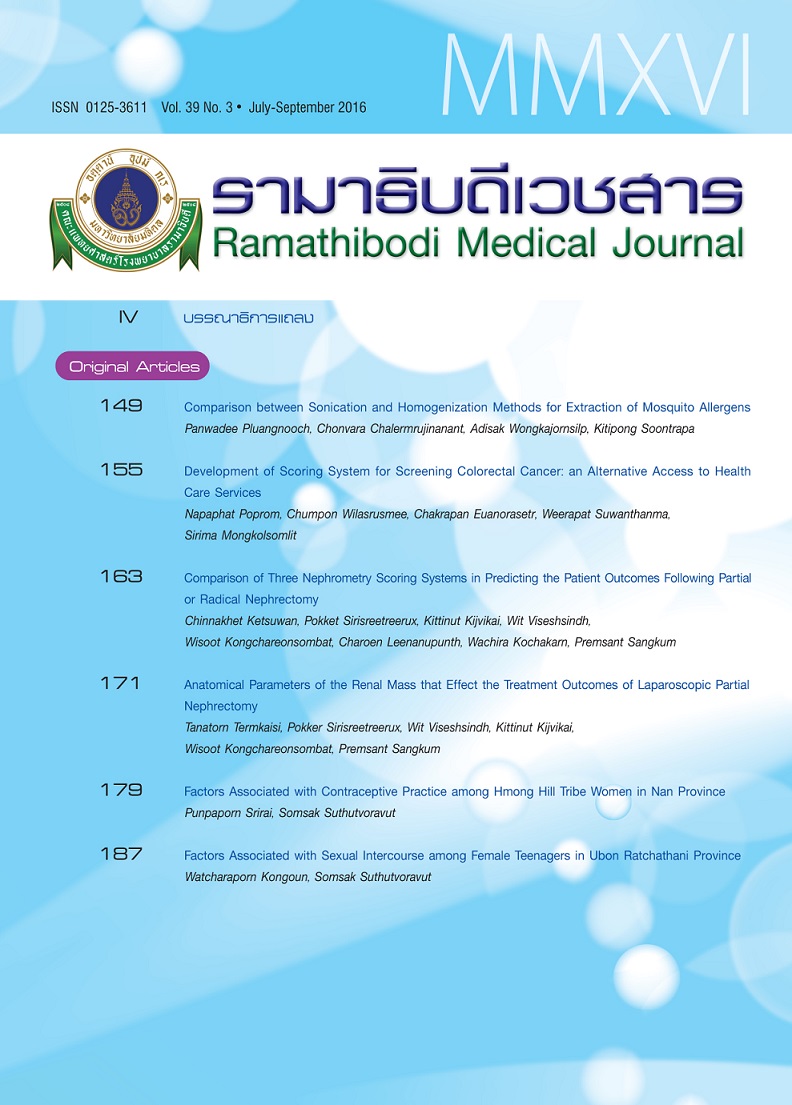Comparison of Three Nephrometry Scoring Systems in Predicting the Patient Outcomes Following Partial or Radical Nephrectomy
Main Article Content
Abstract
Background: Multiple nephrometry scoring systems are developed to evaluate anatomical characteristics of renal mass and help the preoperative decision making for partial nephrectomy. However, there are limited data on the comparison among these scoring systems in predicting perioperative and postoperative outcomes after surgical treatment of renal mass.
Objective: To compare the correlation of three nephrometry scoring systems with perioperative and postoperative outcomes following surgical treatment of renal mass.
Materials and Methods: We conducted a retrospective analysis including the patients with renal mass (diameter < 7 cm) who underwent partial nephrectomy or radical nephrectomy. Three nephrometry scores were evaluated in each patient, including centrality-index (C›Index), preoperative aspects and dimensions used for anatomic (PADUA) score, and radius, exophyic/endophytic, nearness, anterior/posterior, and location (R.E.N.A.L.) nephrometry scores. We evaluated the differences between the partial and radical nephrectomy groups in terms of these three mean scoring systems and analyzed the correlation with postoperative outcomes.
Results: A total of 83 patients were included. There were significant differences in the mean scores of these three systems between partial and radical nephrectomy groups (6.5 vs 8.6, P < 0.001 in R.E.N.A.L nephrometry
score, 7.3 vs 8.7, P < 0.001 in PADUA score, and 2.2 vs 1.3, P < 0.005 in C-Index). With regard to the outcome of the partial nephrectomy, R.E.N.A.L. nephrometry score was significantly associated with the warm ischemia time (WIT) and percentage change in estimated glomerular filtration rate (eGFR) (P = 0.001). PADUA score was significantly associated with WIT (P = 0.039), whereas C-Index was significantly associated with percentage change in eGFR (P = 0.011). There was no significant correlation among all three scoring systems with operative time, postoperative complications and estimated blood loss.
Conclusion: All three nephrometry scores were found to be the useful tools aiding the surgeon decision between partial and radical nephrectomy. R.E.N.A.L. nephrometry score had more benefit over C-index and PADUA score in the aspect of correlation with WIT and percentage change in postoperative eGFR in the patients who underwent partial nephrectomy. However, further large-scale prospective studies are needed to confirm our results.
Article Details
References
MacLennan S, Imamura M, Lapitan MC, Omar MI, Lam TB, Hilvano-Cabungcal AM, et al. Systematic review of oncological outcomes following surgical management of localised renal cancer. Eur Urol. 2012;61:972-93.
MacLennan S, Imamura M, Lapitan MC, Omar MI, Lam TB, Hilvano-Cabungcal AM, et al. Systematic review of perioperative and quality-of-life outcomes following surgical management of localised renal cancer. Eur Urol. 2012;62:1097-117.
Campbell SC,†Novick AC,†Belldegrun A,†Blute ML,†Chow GK,†Derweesh IH, et al. Guideline for management of the clinical T1 renal mass. J Urol. 2009;182:1271-9.
Canter D, Kutikov A, Manley B, Egleston B, Simhan J, Smaldone M, et al. Utility of the R.E.N.A.L. nephrometry scoring system in objectifying treatment decision-making of the enhancing renal mass. Urology. 2011;78:1089-94.
Kutikov A, Uzzo RG. The R.E.N.A.L. nephrometry score: a comprehensive standardized system for quantitating renal tumor size, location and depth. J Urol. 2009;182:844-53.
Ficarra V, Novara G, Secco S, Macchi V, Porzionato A, De Caro R, et al. Preoperative aspects and dimensions used for an anatomical (PADUA) classification of renal tumors in patients who are candidates for nephron-sparing surgery. Eur Urol. 2009;56:786-93.
Simmons MN, Ching CB, Samplaski MK, Park CH, Gill IS. Kidney tumor location measurement using the C index method. J Urol. 2010;183:1708-13.
Okhunov Z, Rais-Bahrami S, George AK, Waingankar N, Duty B, Montag S, et al. The comparison of three renal tumor scoring systems: C-Index, PADUA, and R.E.N.A.L. nephrometry scores. J Endourol. 2011;25:1921-4.
Cockcroft DW, Gault MH. Prediction of creatinine clearance from serum creatinine. Nephron. 1976;16:31-41.
Moll F, Rather P. The surgeon and his intention: Gustav Simon (1824-1876), his first planned nephrectomy and further contributions to urology. World J Urol. 1999;17:162-7.
Hayn MH, Schwaab T, Underwood W, Kim HL. RENAL nephrometry score predicts surgical outcomes of laparoscopic partial nephrectomy. BJU Int. 2011;108:876-81.
Bruner B, Breau RH, Lohse CM, Leibovich BC,†Blute ML.Renal nephrometry score is associated with urine leak after partial nephrectomy. BJU Int. 2010;108:67-72.
Simhan J, Smaldone MC, Tsia KJ, †Canter DJ,†Li T,†Kutikov A. Objective measures of renal mass anatomic complexity predict rates of major complications following partial nephrectomy. Eur Urol. 2011;60:724-30.
